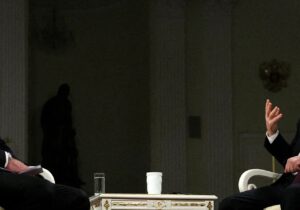In the month since the heinous terrorist attack on a Moscow concert hall, most analyses have focused on Putin’s ludicrous instant assertion that Ukraine and its Western backers were behind the attack. This is, of course, refuted by a few inconvenient facts. First, it only took the Islamic State – Khorasan Provence (ISIS-K) a few hours to publicly claim responsibility for the act of terror. And we now know U.S. intelligence agencies gave notice to Russian officials of an impending attack on the exact target. Simultaneously, after Russian authorities charged four Tajikistani nationals in connection with the attack, the Kremlin is cracking down on Central Asian migrants at large.
But this all misses a central point, which is that since Putin wishes to play the blame game, if anything, it is Moscow that has emboldened extremists in its immediate neighborhood and beyond in recent years.
The Taliban takeover of Afghanistan in August 2021 has allowed the country to once again become a breeding ground for Islamic extremism—and particularly for ISIS-K, which is headquartered in Afghanistan but whose terror was initially tempered by the U.S. presence in the country. The Russian government, meanwhile, embraced the Taliban and its rise back to power in August 2021. That July, Russian authorities welcomed a Taliban delegation to Moscow, which reassured the Kremlin that Taliban gains in Afghanistan would not threaten Russian security or its position in Central Asia. It was at least the fifth time a Taliban delegation visited Moscow in less than five years.
The week the Taliban retook Kabul, the Russian ambassador to Afghanistan praised the group and called its actions “good, positive, and businesslike.” The common refrain at the time was that Russia welcomed the Taliban back to the community of nations so quickly because it wanted to gain the Taliban’s trust in order to partner on counterterrorism measures, particularly in relation to ISIS-K.
But since the Taliban’s return to power, ISIS-K attacks in Afghanistan have become more numerous and deadly, and in 2024 alone, ISIS-K has carried out major attacks in Iran and now Moscow. As Army Gen. Richard Clarke, commander of U.S. Special Operations Command, said shortly after the U.S. withdrawal from Afghanistan: “As we look at the Taliban, I don’t think they’re an entity, today, that should be…a counterterrorism partner.”
And at the time, not all of Russia’s security partners were as welcoming or convinced by the Taliban’s assurances. Tajik President Emomali Rahmon, neighboring Afghanistan to the north, immediately vowed not to recognize the Taliban government which he insists was “formed through oppression.” When there was tension along the Tajikistan-Afghanistan border in the fall of 2021 and Tajikistan called upon its Collective Security Treaty Organization (CSTO) allies to help strengthen its security, joint military exercises were held before Moscow implored both sides to take “mutually acceptable measures” to decrease tensions.
Russia proceeded to forge ties with the Taliban. A year after the Taliban’s return and with scant diplomatic recognition globally, Moscow threw the group a lifeline with a trade deal to supply Afghanistan with 1 million tons of gasoline, 1 million tons of diesel, 500,000 tons of liquefied petroleum gas (LPG), and 2 million tons of wheat annually.
All the while, the Russian government has provided cover for extremists elsewhere. Russia was the first country to welcome a delegation of Hamas officials in the weeks following the terrorist group’s brutal October 7, 2023 attacks across southern Israel. On October 16, Russia led a failed attempt to adopt a resolution at the UN Security Council that called for a ceasefire in Gaza all while failing to name or condemn Hamas for its atrocities. And in what should be seen as at least in part a message to Moscow, the next day, the government of Kazakhstan, Russia’s neighbor to the south which is traditionally in line with Russia on such matters, released a statement that included a condemnation of Hamas’s attacks and the kidnapping of hostages.
And, most inescapably, there is Russia’s ever-expanding partnership with the world’s leading state sponsor of terrorism, the Islamic Republic of Iran—the consequences of which Ukrainians are all too familiar. In mid-2022 at a pivotal moment of Russia’s full-scale assault on Ukraine, Tehran began supplying Moscow with significant quantities of Shahed kamikaze drones which have since brought havoc on Ukrainian civilian infrastructure.
Last December, Ukrainian officials estimated Moscow had launched 3,700 Shahed drones on targets in Ukraine since the launch of its full-scale invasion. Russia is also now constructing a native drone facility with Iran’s help and plans to build 6,000 drones by next summer. These are the same drones that killed three American servicemen in an attack on a base in Jordan earlier this year, and were part of the barrage of 300 drones, ballistic missiles, and cruise missiles Iran launched at Israel on April 13.
If Putin remains committed to his ferocious anti-Western ideology and continues to ally with any actor—no matter how malign—that will bring him closer to his goal of overturning the Western alliance structure, enabling such extremism will be one of the tradeoffs. He has found himself at the center of a burgeoning alliance which is making the world safer for terror and extremism. Western leaders should view thwarting Russia’s ambitions in Ukraine as an important element of ensuring such a world order never comes to fruition.






